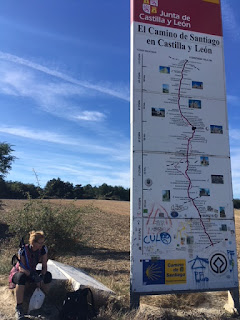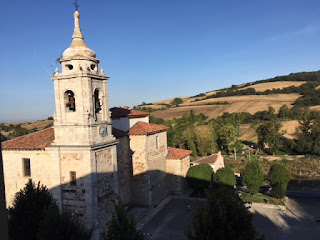Don’t freak out too much. My ancestor was a cannibal too. In fact,
anyone whose ancestors can be traced back to some part of Europe shares this
shocking fact.
The oldest human remains in the whole of Europe have been found in
Atapuerca, just a couple of kilometres off the Camino de Santaigo. They were
not Homo Sapiens, and not even Neanderthals, but Homo Antecessors, who are currently
thought to be the common ancestor to both Neanderthals and Homo Sapiens. Now
that we know Neanderthals were not part of the progression we Homo Sapiens
took, but rather our “cousins”, who we most probably killed off, nothing comes
as a surprise.
Except finding out our ancestors were cannibals.
The remains in this region were discovered when a train line was
being put in towards a mining area, in the 1960s. Since then, human fossils
have been found that date back from 127,000 years ago to – wait for it – over
1,200,000 years ago! These are still being found – at this point the vast
number total more than 90% of every single pre-Neanderthal fossil found anywhere
in Europe.
In 2000, UNESCO declared this a World Heritage site of great
importance. Beyond the actual fossils, an impressive amount of information has
been gleaned or, literally, unearthed, as to how Home Antecessors lived, how
their communities developed and what they ate (including other homonids!). The active
archaeological site itself is closed to visitors, although there is an
information site in town, which was closed, being Monday (???).
 |
| in Atapuerca town |
Much better to wait until Burgos and check out the Museum of Human
Evolution.
Which we did, spending about 3 hours there. It is a very good
museum, taking not just what has been found at Atapuerca, but putting it into
the context of humanity. Who are we? Where do we come from? Where are we Going?
The three key questions we ask of ourselves, philosophically at first but now
also scientifically, due to the work first published by Charles Darwin in The
Origin of Species. That work of reasoning has pervaded all social and natural
sciences as disparate as law, economics and medicine.
Which makes it all the more interesting to contemplate as we are on
the Camino walk, which for centuries has been about faith in the mysteries of
the world, primarily Christian faith, so many of which have now been answered
by science. Religion has to reckon with Science, and this is hard for some
people to deal with. It’s either a rejection of belief in something that can’t
be proven and yet which demands blind faith, or it’s a rejection of the new knowledge
that the world has given into the hands of scientists of researchers.
The museum put this well:
The best
evidence for the theory of evolution can be found in the existence in species
which ar very different in form and habitat but which share many basic traits
in terms of their anatomy, physiology, embryonic development, metabolism and
chemical structure.
The fact that
all the different organisms on the planet , including human beings, share the
same genetic code proves beyond a doubt that we are all descended from an
ancient life form, the common ancestor of all species.
It is amazing to think that our evolution began so many
million years ago and, through a more or less random set of circumstances,
allowed us humans to not only exist today but flourish, and continue the journey
of change. So many other species were wiped out, leaving only fossils to puzzle
over.
But what makes us different than any other animal is: 1) we can
make fire and cook our food, 2) we bury our dead, 3) we make art for art’s sake,
and 4) we have the concept of the future (tomorrow, next week, next year – not other
creature has that capacity)
Now wonder man has wondered what the purpose of life is when
we contain these things that are unique in the world. Our language became symbolic,
with rites and rituals, and the development of religion has been an outcome
developed to the highest form of thought and practice. I shudder to think what
human beings would have done to one another without the fear of hell to deal
with after death, but that did not stop enough bad things done in the name of
religion either.
I am a follower of science, but when I sit in a cathedral,
listening to complex and accomplished music, looking at art so exquisite and
well-crafted that it took decades to produce and that produces in me a kind of
ache of joy at its beauty, listening to stories told in poetry that has
inspired people for centuries, it really doesn’t matter whether they were in the
service of religion or commerce. That fact they are here at all is incredible
and wonderful, a mystery of the human spirit and capacity.
 |
outside the museum in Burgos
skull as kiddie climbing toy |






















































